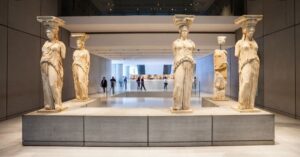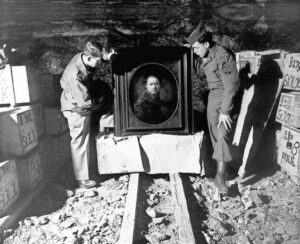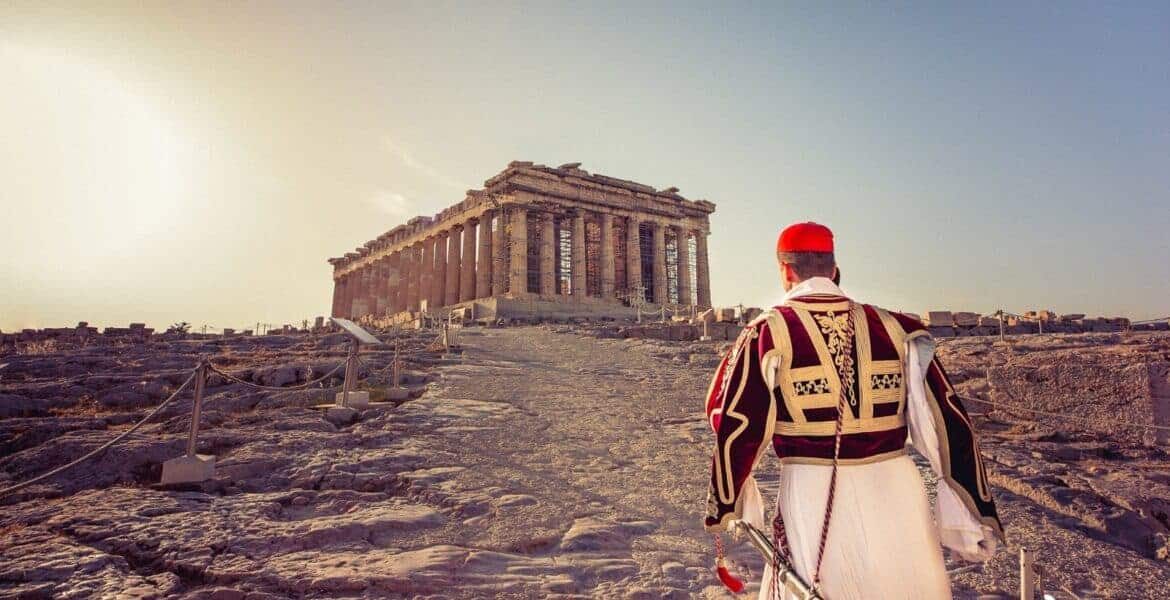That we've broken their statues,
that we've driven them out of their temples,
doesn't mean at all that the gods are dead.- IONIAN, Constantine Cavafy
For nearly five months, we have been discussing the history of the Parthenon Sculptures and considering from various angles whether they belong all together in the purpose-built Acropolis Museum or should remain divided, half in London and half in Athens, with a continent in between.
This question has always been framed as a zero-sum dispute, with a winner on one side and a loser on the other, especially if the issue goes to court. From the outside, it often appears as an insoluble impasse in which Athens has a clear moral and ethical claim; London has all the advantages of possession, inertia and the status quo – while neither party has a clear path to victory, like Godzilla vs. King Kong.
Although the situation might appear grim, museums around the world are actually changing in exciting ways, evolving into fascinating, flexible centers for education and innovation - by creatively solving old problems and forging new relations with source countries and their own communities. But before exploring the framework within which this dispute might be amicably resolved, let's take a brief, final look this week at the arguments for and against the return of the Parthenon Sculptures to Athens - and then move on.
Argument For
In reality, there is just one argument for return and reunification. It is simple and clear, based on justice and common sense. It involves looking at the issue from all possible angles, as we have tried to do in this column, and then answering the question: “What is the right thing to do?”
Arguments Against
The arguments against returning the Sculptures all spring from the powerful human fear of losing something, a trait called by psychologists “loss aversion”. One of the principal consequences of ownership and possession is that we overvalue what we have and fear its loss – to such a degree that we undervalue anything we might stand to gain through a change in this situation – no matter how great the possible benefits might be. This same fear sends us scrambling for excuses and justifications in defense of the status quo and impels us to blindly, even desperately, focus on hanging on to what we have – at all costs. That is why arguments against change are often so protean, so full of evasion, half-truths, untruths, scaremongering and red herrings. We can plainly see this in the case of the British Museum’s efforts to hang on to the Parthenon Sculptures, even though they are an albatross around the Museum’s neck and the main obstacle to becoming an even greater institution. This is also why these arguments are so difficult to answer – because the issue is not really the objection as stated but the underlying fear, which must be addressed in a different way, out of understanding and shared concern rather than confrontation. According to Daniel Kahneman and Amos Tversky’s “Prospect Theory”: “Losses loom larger than gains.”
With that in mind, here are some of the main arguments used over the past 200 years by the British Museum to justify retention of the Sculptures. Let us take a final look and then move on.
“It was all perfectly legal”
This is the standard first response – meant to nip all discussion in the bud. It is the centerpiece of a colourful hodge-podge of legal and ethical claims which sound convincing – especially when repeated by senior Government and Museum officials – but which fall apart under closer scrutiny. The claims persist, however, because it is rightly assumed that few people have the time or motivation to undertake the sleuthing needed to disprove them. For instance, the Museum has for many years claimed that:
Lord Elgin requested permission from the proper authorities to remove sculptures from the Parthenon walls. Ottoman officials gave Elgin such written permission in the form of a firman. Elgin did not abuse his position as the British ambassador in securing this permission. Elgin did not bribe Ottoman officials to look the other way as his men stripped the Parthenon of its sculptures. Elgin was motivated by patriotism and altruism to save the sculptures from vandalism and deterioration. Elgin did not damage the temples of the Acropolis. Furthermore, In 1816 Parliament thoroughly investigated Elgin’s activities and concluded that they were entirely legal.
However, available evidence, testimony and research (from Hansard, Ottoman archives and new documents obtained under The Freedom of Information Act 2000) establish that: Elgin did not request permission to remove the sculptures from the Parthenon walls and did not receive permission to do so; Elgin abused his position as ambassador and employed bribery to gather his collection; Elgin’s purpose was not to elevate the arts in Britain but to decorate his home in Scotland; his men did irreparable damage to the Parthenon; and the Parliamentary Select Committee of 1816 did not conclude that Elgin’s activities were legal. In the Committee’s report there is not one sentence, phrase or word implying that what Elgin did was legal, much less ethical. The leading lawyer on the Committee, MP Sargeant Best, expressed the dilemma and disquiet of the members in this way: “These Marbles were brought to this country in breach of good faith”. This essential disquiet has been at the heart of the Museum’s “Elgin problem” since the very beginning, and things are only getting worse.
The British Museum Act 1963
The Museum Trustees have long hidden behind this piece of legislation, which prevents them from deaccessioning artefacts from the Museum’s collection except under the most limited circumstances. But whenever the Government and Museum Board do jointly decide it is in their best interest to return something, they simply need to have Parliament pass enabling legislation, as they did for the return of Nazi loot and again for human remains. Legislation was enacted in both cases. The sky did not fall. No floodgates opened, and everyone benefited.

Location, Location, Location
Britain has always maintained that the Sculptures are safer, better cared for and seen by a greater number of people In London than they would be in Athens, but even if that were true a century ago, it is true no longer. One has only to see the Sculptures now in London (when the Duveen Galleries are dry enough to open again) and then visit the Acropolis Museum in Athens to understand where they belong.
Floodgates and the Universal Museum
These two arguments are still used today to try to hold back the tides of history, justice and public opinion, which are moving inexorably toward the return and reunification of these Sculptures. We explored the notorious “Floodgates Argument” in an earlier column, and in the previous column we examined the ponderous and slippery confection of the “Universal” or “Encyclopedic Museum”. These two arguments, inspired by the magnificent Thames Barrier, are a flimsy and temporary defense against doing the right thing, which is far more deeply ingrained in the British character than evasion and spin.

But the difference between the arguments for and against really boil down to a difference in attitude and ethos, best displayed in the two short excerpts below. The first example comes from comments made by Conservative MP Tim Loughton (East Worthing and Shoreham) speaking in Parliament on March 2, 2020 at a session to discuss the repatriation of the Parthenon Sculptures:
“I am enjoying the history lesson, 204 years after the Select Committee of this House thoroughly investigated the acquisition and found it to be totally legal. However, the hon. Lady says the marbles could be better appreciated in Athens. Why does she think they could be better appreciated in Athens? They are possessions of the world, and the British Museum, as a world museum, is the best place for everyone to appreciate them, rather than this petty nationalism about sending them back to a city state that does not exist any more.” - Conservative MP Tim Loughton (East Worthing and Shoreham)

In 1943, the Allied armies created a team of military and civilian art experts popularly known as “The Monuments Men” (The Monuments, Fine Arts and Archives program) to prevent looting and return works of art stolen by the Nazis. In 1945, when this group learned of a plan by the Allied forces to seize German art works, they drafted the Wiesbaden Manifesto. Although the excerpt below hails from an earlier time, it represents universal, timeless values – and integrity.
“We wish to state that from our own knowledge, no historical grievance will rankle so long, or be the cause of so much justified bitterness, as the removal, for any reason, of a part of the heritage of any nation, even if that heritage may be interpreted as a prize of war. And though this removal may be done with every intention of altruism, we are none the less convinced that it is our duty, individually and collectively, to protest against it, and that though our obligations are to the nation to which we owe allegiance, there are yet further obligations to common justice, decency, and the establishment of the power of right, not might, among civilized nations.” – The Wiesbaden Manifesto, 1945

NEXT WEEK: Don Morgan Nielsen looks at a few examples of how museums and source nations are starting to work together to turn the repatriation of artefacts into a new bridge for dialogue, cooperation and opportunity.
ABOUT THE PARTHENON REPORT | DON MORGAN NIELSEN:
In this bicentennial year since the birth of the modern Greek State, of both pandemic and celebration, Greek City Times is proud to introduce readers to a weekly column by Don Morgan Nielsen to discuss developments in the context of history, politics and culture concerning the 200-year-old effort to bring the Parthenon Sculptures back to Athens.
Classicist, Olympian and strategic advisor, Don Morgan Nielsen is currently working with a growing international team to support Greece’s efforts to repatriate and reunify the Parthenon Sculptures.
Featured Image: Copyright Nick Bourdaniotis | Bourdo Photography
Click here to read ALL EDITIONS of The Parthenon Report by Don Morgan Nielsen


